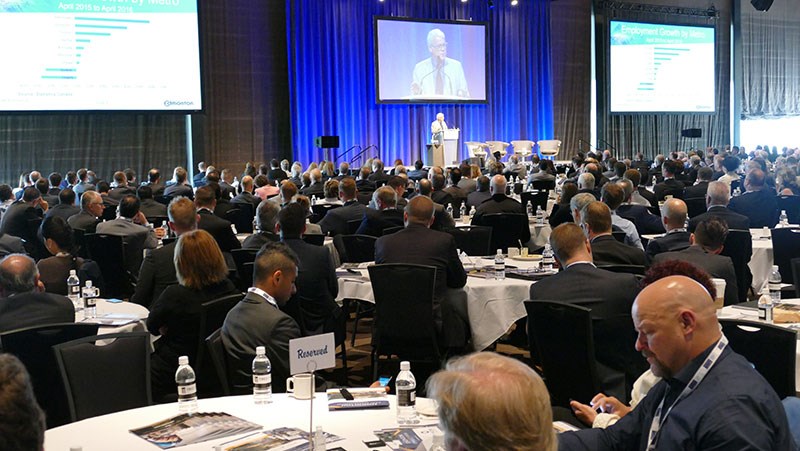When John Rose, chief economist for the City of Edmonton took the stage at the Edmonton Real Estate Forum he quickly dismissed fears that Alberta’s capital city is losing jobs and people beneath the oil price slide.
Edmonton’s year-over-year job growth is 3.6 per cent, Rose noted, second only to Vancouver among major Canadian cities, and Edmonton gained 30,534 new residents, net, in 2015, including 11,455 people from other provinces and more than 4,300 immigrants from other countries.
Edmonton generated 31,000 new jobs in the first quarter of this year alone, Rose told the Forum audience, and the sectors that are growing – logistics, professional services and the information and cultural industries – reflect the shifting economy in the province’s second-biggest city. Even with the oil downturn, the average household income in Edmonton is $111,942, compared to a Canadian average of $90,536.
Many of the new jobs are tied to construction in a city where total building permits spiked to $2 billion in the first quarter, more than half of which was non-residential.
Gathered at the Shaw Conference centre, Real Estate Forum delegates only had to glance outside to witness how the new economy is altering Edmonton’s skyline. Nearby, the ICE District is underway, ushering in a new homes, a new NHL hockey arena for the Oilers, and one of the largest office towers in Canada. The 62-storey Stantec tower, now under construction for a 2018 opening, will be joined by a new Marriott luxury hotel tower, both evidence that Edmonton’s future is about more than oil prices.
It is growth in accounting firms, engineering and high-tech that is fueling downtown office demand, noted Avison Young principal Cory Wosnack who chaired a panel discussion on Edmonton’s office market.
Taking advantage of a rise in downtown office vacancies — and compressed lease rates – a number of high-tech firms have expanded their office space. Among these are Cybertech, a system integration company, Granify, an online behavioural analysis company, and Ontracks Consulting, an operational improvement firm. Edmonton game start-ups like BioWare, Rocketfuel, and Madsoft Games are among those also hiring.
Of the three biggest new Class A office towers completing by next year – Stantec, Kelly Ramsey Tower and the Edmonton tower – less than 300,000 of the total of 1.8 million square feet is leased to the energy sector (Enbridge). Financial services, engineering, law and professional services firms, claim the rest. Accounting firms alone will lease up more than 200,000 square feet downtown this year, the Forum office panel was told.
Retail
The critical mass of young workers and residents downtown will put pressure on retailers to step up, the Forum was told.
“The challenge we have right now in trying to fill some of the development in the Edmonton arena district is we don’t have the infrastructure assets in place in downtown to make it a desirable place to live,” said Michael Smith, senior vice-president for multi-family at WAM Development Group, during a retail panel discussion.
While downtown Edmonton is rich in institutional assets such as the under-construction Royal Alberta Museum, Smith said that’s not enough to convince people to move downtown.
“We don’t have that strong lifestyle retail component,” said Smith, whose company is co-developing the arena district.
Alberta posted $12.4 billion in retail sales in the first two months of this year, up from $12.2 million in the same period a year earlier – the strongest performance in Western Canada, according to a Cushman & Wakefield retail report at the Forum.
“Edmonton is outperforming retail expectations,” noted Cushman & Wakefield partner Brett Killips.
Encouraging a livable downtown demands more than fancy towers and hockey, the panel agreed. It needs pharmacies, dry cleaners, food stores, banks and other basic shopping outlets to serve the new urban consumers. New park space and improved transit would also help, the experts said.
But Edmonton remains a suburban-centric shopping city. For example, when luxury retailer Saks Fifth Avenue inked an agreement for its new 30,000-square-foot Saks Off Fifth outlet store, it chose to locate not downtown but in the Skyview power centre in north Edmonton.
Industrial
Edmonton’s industrial vacancy rate has risen to 5.8 per cent, the Forum was told, more than double the 2.5 per cent vacancy a year ago. And lease rates have fallen 5 per cent from the first quarter of last year. But, with the price of oil rallying recently to near US$50 a barrel, the resource sector – and the industrial market that serves it – could also experience a recovery, the Forum heard.



